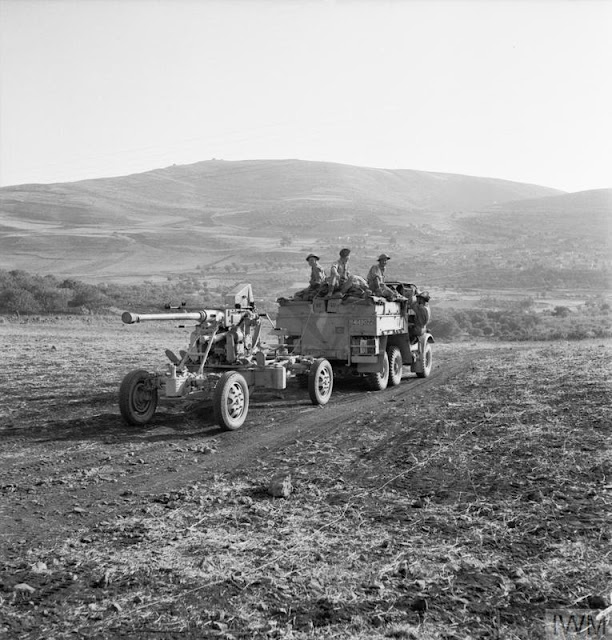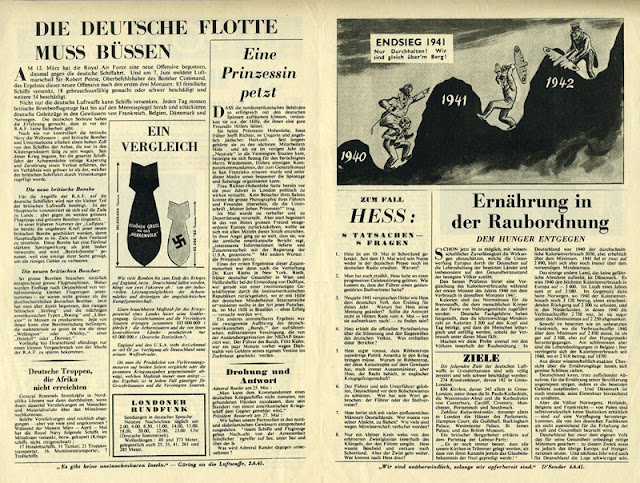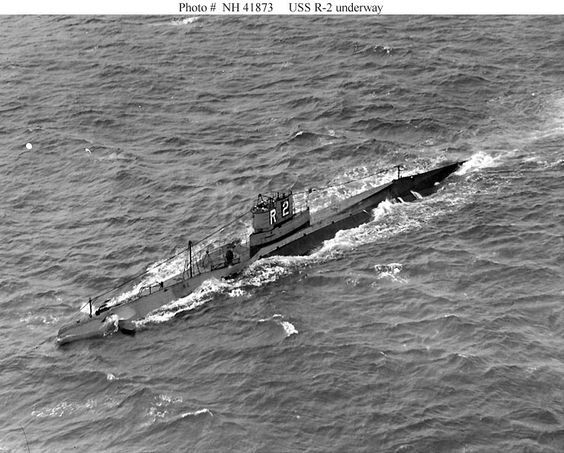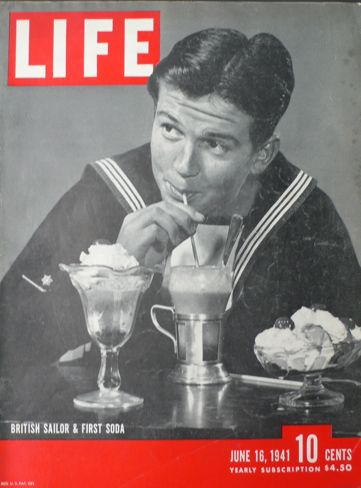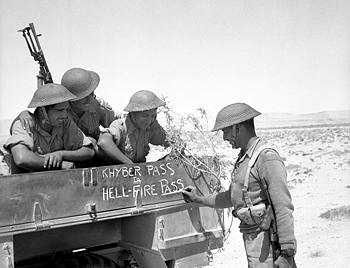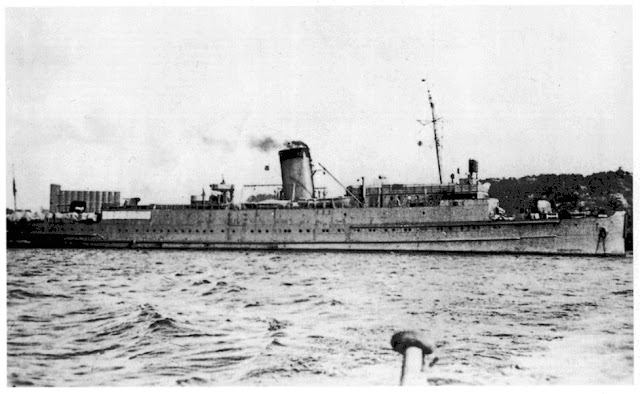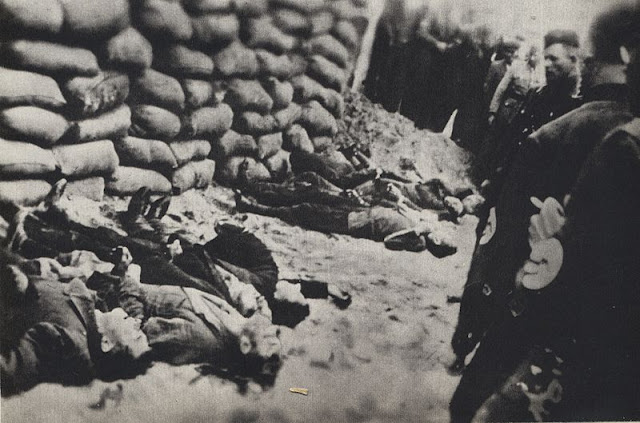Tuesday 17 June 1941
Syrian/Lebanon Campaign: The Battle of Kissoué has resolved on 17 June 1941 after fierce fighting in the hills south of Damascus. The British win, but it is only a stepping-stone to more important objectives.
British Gentforce under Major-General Paul Legentilhomme (now wounded and replaced by the commander of the 5th Indian Infantry Brigade, Brigadier Wilfrid Lewis Lloyd) now plans to advance further. It will use the two main roads from the south - passing through Quneitra and Kissoué - to attack Damascus. However, there is a slight problem - the Vichy French have retaken Quneitra (Kuneitra) on one of the two roads. However, the British 16th Infantry Division can bypass the town without too much trouble.
The British, despite the setback at Quneitra, decide that offense is the best defense and decide to attack north to Damascus anyway. So, the British plan to send the 5th Indian Brigade north from Aartouz along the Quneeitra road early on the 18th.
The battle in front of Damascus saps British strength elsewhere. Lieutenant-General Lavarack sends part of the Australian 21st Brigade from Sidon on the coast to reinforce Jezzine. They managed to blunt a Vichy French attack there along with the Australian 25th Brigade. In the east, Free French Senegalese troops take Ezraa after a hard battle, with the Vichy French losing 160 prisoners and the Senegalese losing 70 prisoners. At Merdjayoun, an Australian attack is stopped by the determined Vichy French resistance.
RAF bombers attack a French destroyer carrying ammunition which has evaded the blockade and made it to Beirut. The ship is further damaged.
The British still feel in control of the campaign, but a sense of wonder infuses General Henry Maitland Wilson's headquarters in Jerusalem. The Vichy French were not supposed to resist, and defectors consistently reported that morale in Syria and Lebanon were terrible. However, the troops on the ground have been fighting fiercely over villages and towns that have no meaning. Why all this resistance from an army that was an ally only one year before?
Some answers come from the prisoner of war camps. Interrogations show that the Vichy French actually have excellent morale. However, it comes from a curious source: sheer pride. The French POWs claim that they are tired of being disparaged by both sides for their supposed lack of military prowess. In particular, they resent being lumped in with the Italians as ineffective (the French handily stopped the bulk of the Italian army along the Riviera coast in 1940). By resisting the British, they are proving something to the world - and to themselves.
The British order Habforce from Baghdad back into Syria, creating a long round-trip for the weary soldiers.
After dark, RAF Bomber Command continues its raids on western German targets, attacking Cologne (75 bombers), Duisburg (26) and Dusseldorf (57).
RAF Air Chief Marshal Sir Philip Joubert, the new commander of Coastal Command, for the first time reveals that the RAF is using radio-location (RDF, or radar) to guide its planes. He reveals that Robert Watson-Watt developed the system.
Battle of the Atlantic: German surface raider Atlantis, disguised as the Dutch motor-ship Brastagi, is operating a few hundred miles west of Ascension Island when it spots a target. Atlantis sinks 4760-ton British freighter Tottenham with gunfire after taking off the crew. Tottenham goes down with much-needed supplies for the Western Desert forces, including aircraft, ammunition, trucks, and cars. The Atlantis takes 26 crew prisoners of war, while 17 others take to the boats and eventually make it to Trinidad on 2 July.
U-43 (Kptlt. Wolfgang Lüth), on its seventh patrol out of Lorient and shadowing Convoy SL-76, at 03:17 torpedoes 2727-ton British freighter Cathrine. The Cathrine carries 3700 tons of manganese ore and goes down quickly about 250 nautical miles (460 km, 290 miles) southwest of Cape Clear, Ireland. There are 24 deaths and three survivors. The three survivors are in a lifeboat, but spend 33 days before being rescued by a passing British trawler.
Royal Navy AMC HMS Pretoria Castle spots 9645-ton Vichy French freighter Desirade east of the Antilles. The Pretoria Castle seizes the Desirade.
The Canadian ferry Charlottetown runs aground off Port Mouton, Novia Scotia. It is written off and sinks off Little Hope Island on the 18th. Fortunately, the Charlottetown has no passengers on board, and nobody is hurt.
The Luftwaffe bomb and damage 833-ton British freighter Jim near Tyne. The ship makes it back to Tyne.
Canadian destroyer HMCS St. Clair collides with oiler Clam and has to return to St. John's. The destroyer is badly damaged and is not returned to service until 2 December.
Minelayer HMS Plover lays minefield BS.58 in the North Sea.
The Canadians recall their destroyers serving in Europe in order to beef up the Newfoundland Escort Force (NEF).
Royal Navy minesweeper HMS Blyth (Commander Grenville M. Temple) and ASW trawler Polka (Lt. Kenneth C. Donaldson) are commissioned.
Canadian corvette HMCS Rosthern (Lt. Walter Russell) is commissioned and minesweeper Lockeport is laid down in North Vancouver.
Free Polish destroyer ORP Kujawiak is commissioned (originally built as HMS Oakley).
Vichy French corvette FS Alysse (Jacques P. Lehalleur) is commissioned.
Battle of the Mediterranean: On the Libyan frontier, the British offensive, Operation Battleaxe, has turned against them. Following initial reverses, General Erwin, helped by intercepts of Australian radio communications, now has the upper hand after masterful handling of his forces. As the day begins, the British still cling to their only gain of the offensive, Fort Capuzzo, but elsewhere they have been sent reeling.
At 04:30, the 5th Light Brigade resumes its counterattack against the British 7th Armoured Brigade. By 06:00, the Germans grind into the British positions and start pushing them back again.
At Fort Capuzzo, the British have planned a resumption of their offensive, but the Germans have been very active. This activity spooks the British commander, General Frank Messervy, who cancels the attack. The confusion on the British side reaches a fever pitch, and Middle East Commander General Archibald Wavell hurriedly boards a plane to fly from Cairo to the command post of front commander General Noel Beresford-Peirse at Sidi Barrani.
Meanwhile, General Rommel is reading the British wireless messages in real-time and knows that Wavell himself now is involved. As he writes later:
This is one of Rommel's truly great operations, though little-remembered amongst his other successes. He demonstrates true talent as a counter-puncher, turning a well-played defensive battle into an opportunity to push the enemy back. Rommel reorients his counter-offensive on the fly to take account of the changed circumstances. He directs the 5th Light Division and 15th Panzer Division in a concentric attack, the former from the southwest and the latter from the northwest, on Halfaya, to destroy the fleeing British troops. The panzers reunite with their trapped comrades in Halfaya Pass without difficulty and only fail to encircle the main body of British tanks and infantry because they are headed east so fast.
At 10:00, the Germans brush aside the remaining tanks of the 4th Armoured Brigade, which was ruined by previous ill-fated attacks on German positions protected by hidden anti-tank guns. The local British commanders agree by 10:45 on a general retreat, and the British spend the rest of the day abandoning all of their remaining gains and retreating back into Egypt.
June 17, 1941, marks the last remnant of Operation Battleaxe, which has been a disaster for the British. The Allies have suffered 122 killed, 588 wounded and 259 missing men, while the Germans have 93 killed, 350 wounded and 235 missing. The British also lose 98 tanks (3 light, 30 cruisers, and 65 Matildas), while the Germans lose about 50 tanks total. The Germans recover the field of battle and thus get both their own wrecked tanks to salvage and also the British tanks for study and possible repair. The outcome in the air is similar, with the RAF losing 33 fighters and 3 bombers against total Luftwaffe losses of ten planes.
Luftwaffe ace Hans-Joachim Marseille shoots down two Hawker Hurricanes over Halfaya Pass while flying escort for Junkers Ju 87 Stuka dive-bombers. They are his victories 12 and 13.
Operation Battleaxe has been as futile as Operation Brevity in mid-May despite the concentration of massive British armored forces brought by the Tiger Convoy. The Germans advance to Sidi Suleiman and then pause. Not only have the British not gained any ground, in fact, but they also wind up 30 miles further east than they started.
Dutch submarine O-24 (P 24), commanded by Lt. Commander Otto de Booy, is operating off La Spezia, Italy when it attacks a target. However, the torpedoes miss.
The 173 Tunnelling Company, Royal Engineers is ordered to Malta to dig underground facilities. The government on the island has decided that the surface is becoming too hazardous and wants to build a headquarters, storage area and operating theater in the mountains. An air raid in the early morning hours damages Iz-Zebbieh, Hal Far, Luqa, Ta Qali, and Rabat.
Battle of the Pacific: RAAF Hudson aircraft depart Townsville for Dutch possessions Rabaul and Kavieng. Their mission is to make secret recon flights over Kapingamarangi Atoll, the southernmost point in the Japanese mandated the Caroline Islands. Rabaul itself will become the main Japanese headquarters in the Southern Pacific.
Spy Stuff: The Japanese begin assembling copies of secret charts for Panama from Italian officials. These charts show the location of guns, equipment, and buildings in the Canal Zone. The Japanese, however, are unsure how to get the charts from Panama to Tokyo without the Americans finding out because baggage in the area is being routinely opened and searched.
Pavel M. Fitin, chief of the NKVD Foreign Intelligence, sends Soviet Premier Joseph Stalin a report which asserts in part:
US/Canadian Relations: The US and Canada set up a Joint Economic Committee. Its purpose is to:
German/Swedish Relations: The Swedish government, which leans toward the Allied cause but is surrounded by Axis territory, permits the German 163rd (Erwin Engelbrecht) Infantry Division to use the rail line from Narvik to Helsinki so that it may be used in the Continuation War. This decision is extremely controversial within Sweden for violating neutrality and leads to the "Midsummer Crisis." The division is not yet ready to move, however; that will take place from 25 June through 12 July.
German Military: Adolf Hitler confirms 22 June 1941 as the date for Operation Barbarossa, the invasion of the Soviet Union. The invasion is to begin at 03:00 along three axes of advance: north, center, and south.
About 10,000 Wehrmacht troops assembled in Finland as co-belligerents (technically not allies) head north to take up positions near Petsamo in preparation for Barbarossa. Their aim is to secure vital nickel supplies and advance toward Murmansk.
The Luftwaffe engages in reconnaissance flights over the Soviet Union, largely without being spotted. The photos are of historical interest for showing undamaged locations that soon will become famous for being destroyed by combat. Yesterday the photographed Kharkiv, today Zapolyarny in the far north.
British Military: The British Army reestablishes the Guards Armoured Division. Its first commander is Major General Sir Oliver Leese.
US Military: First flight of the Brewster SB2A Buccaneer, a US single-engined mid-wing monoplane scout/bomber. It is designed for the US Navy, but many are sent to Great Britain. The Buccaneer is found not suitable for combat and is assigned mundane tasks such as target towing and training. On lists of terrible designs, the Brewster Buccaneer places pretty highly for its underpowered engine and lack of maneuverability.
Finnish Military: General Heinrichs, the Finnish Chief of Staff, orders a general mobilization. All reservists up to the age of 44 are to report immediately for duty.
Finland announces that it is leaving the League of Nations, an organization that is moribund anyway.
Iceland: Sveinn Bjornsson is elected Regent of Iceland. While the Iceland military is occupied by the British (and soon the Americans), in other regards it continues to function independently.
The Netherlands: Dutch composer and organist Johan Wagenaar passes away in Den Haag.
Latvia: Soviet deportations of 7000 women, children, and elderly people conclude in Latvia. They are taken to Siberia on freight cars. Everybody is woken before or at dawn without warning, given an hour to pack, and everything that they leave behind is seized by the state.
Holocaust: Using the little-known back-door route to escape Europe, Jewish refugees aboard Japanese ship Hikawa Maru have arrived in Vancouver, Canada. The group includes many families with children.
SS-Obergruppenführer/General der Polizei Reinhard Heydrich conducts a briefing session in his Berlin office. Attending are the commanders of Einsatzgruppe, Einsatzkommando, and Sonderkommando units in preparation for Operation Barbarossa.
Having just returned from a three-day SS conclave held at Castle Wewelsburg, Heydrich sets out in detail the policies to be followed by the Einsatzgruppen ("Task Forces"). These policies will include following the advancing army troops and serving as mobile execution squads of Jews and other undesired locals such as communist functionaries.
There is to be no judicial proceeding, no discussion - the intended victims are to be taken to places outside of town and shot without ceremony. Einsatzgruppen are composed of members of the SS, Gestapo, Criminal Police, and State Security Service. The colloquial name for Einsatzgruppen is "death squads."
American Homefront: New York Yankee Joe DiMaggio gets a hit in his 30th straight game, this one against the Chicago White Sox. This breaks the team record set by Roger Peckinpaugh and Earl Coombs, both of whom are in attendance to see the record fall.
June 1941
June 1, 1941: Farhud Pogrom
June 2, 1941: Massacres on Crete
June 3, 1941: Kandanos Massacre
June 4, 1941: Kaiser Wilhelm Passes Away
June 5, 1941: Death in Chungking
June 6, 1941: Hitler's Commissar Order
June 7, 1941: Commandos Strike at Pessac
June 8, 1941: British Invade Syria and Lebanon
June 9, 1941: Litani River Battle
June 10, 1941: British Take Assab
June 11, 1941: Hitler Thinking Beyond Russia
June 12, 1941: St. James Agreement
June 13, 1941: Lützow Damaged
June 14, 1941: Latvian June Deportations
June 15, 1941: Operation Battleaxe
June 16, 1941: The Old Lion
June 17, 1941: British Spanked in North Africa
June 18, 1941: Turkey Turns Its Back
June 19, 1941: Cheerios Introduced
June 20, 1941: Birth of US Army Air Force
June 21, 1941: Damascus Falls
June 22, 1941: Germany Invades Russia
June 23, 1941: A Soviet KV Tank Causes Havoc
June 24, 1941: Kaunas and Vilnius Fall
June 25, 1941: Finland Declares War
June 26, 1941: Bombing of Kassa
June 27, 1941: Encirclement At Minsk
June 28, 1941: Minsk Falls
June 29, 1941: Brest Fortress Falls
June 30, 1941: Mölders Becomes Top Ace
2020
British Gentforce under Major-General Paul Legentilhomme (now wounded and replaced by the commander of the 5th Indian Infantry Brigade, Brigadier Wilfrid Lewis Lloyd) now plans to advance further. It will use the two main roads from the south - passing through Quneitra and Kissoué - to attack Damascus. However, there is a slight problem - the Vichy French have retaken Quneitra (Kuneitra) on one of the two roads. However, the British 16th Infantry Division can bypass the town without too much trouble.
The British, despite the setback at Quneitra, decide that offense is the best defense and decide to attack north to Damascus anyway. So, the British plan to send the 5th Indian Brigade north from Aartouz along the Quneeitra road early on the 18th.
The battle in front of Damascus saps British strength elsewhere. Lieutenant-General Lavarack sends part of the Australian 21st Brigade from Sidon on the coast to reinforce Jezzine. They managed to blunt a Vichy French attack there along with the Australian 25th Brigade. In the east, Free French Senegalese troops take Ezraa after a hard battle, with the Vichy French losing 160 prisoners and the Senegalese losing 70 prisoners. At Merdjayoun, an Australian attack is stopped by the determined Vichy French resistance.
RAF bombers attack a French destroyer carrying ammunition which has evaded the blockade and made it to Beirut. The ship is further damaged.
The British still feel in control of the campaign, but a sense of wonder infuses General Henry Maitland Wilson's headquarters in Jerusalem. The Vichy French were not supposed to resist, and defectors consistently reported that morale in Syria and Lebanon were terrible. However, the troops on the ground have been fighting fiercely over villages and towns that have no meaning. Why all this resistance from an army that was an ally only one year before?
Some answers come from the prisoner of war camps. Interrogations show that the Vichy French actually have excellent morale. However, it comes from a curious source: sheer pride. The French POWs claim that they are tired of being disparaged by both sides for their supposed lack of military prowess. In particular, they resent being lumped in with the Italians as ineffective (the French handily stopped the bulk of the Italian army along the Riviera coast in 1940). By resisting the British, they are proving something to the world - and to themselves.
The British order Habforce from Baghdad back into Syria, creating a long round-trip for the weary soldiers.
After dark, RAF Bomber Command continues its raids on western German targets, attacking Cologne (75 bombers), Duisburg (26) and Dusseldorf (57).
RAF Air Chief Marshal Sir Philip Joubert, the new commander of Coastal Command, for the first time reveals that the RAF is using radio-location (RDF, or radar) to guide its planes. He reveals that Robert Watson-Watt developed the system.
 |
| "These men, who have finished their training course at HMS GORDON, signed on for service with the Royal Navy but were asked to volunteer for the Merchant Navy instead." June 1941, taken by Lt. Col. LC Priest © IWM (A 4464). |
U-43 (Kptlt. Wolfgang Lüth), on its seventh patrol out of Lorient and shadowing Convoy SL-76, at 03:17 torpedoes 2727-ton British freighter Cathrine. The Cathrine carries 3700 tons of manganese ore and goes down quickly about 250 nautical miles (460 km, 290 miles) southwest of Cape Clear, Ireland. There are 24 deaths and three survivors. The three survivors are in a lifeboat, but spend 33 days before being rescued by a passing British trawler.
Royal Navy AMC HMS Pretoria Castle spots 9645-ton Vichy French freighter Desirade east of the Antilles. The Pretoria Castle seizes the Desirade.
The Canadian ferry Charlottetown runs aground off Port Mouton, Novia Scotia. It is written off and sinks off Little Hope Island on the 18th. Fortunately, the Charlottetown has no passengers on board, and nobody is hurt.
The Luftwaffe bomb and damage 833-ton British freighter Jim near Tyne. The ship makes it back to Tyne.
Canadian destroyer HMCS St. Clair collides with oiler Clam and has to return to St. John's. The destroyer is badly damaged and is not returned to service until 2 December.
Minelayer HMS Plover lays minefield BS.58 in the North Sea.
The Canadians recall their destroyers serving in Europe in order to beef up the Newfoundland Escort Force (NEF).
Royal Navy minesweeper HMS Blyth (Commander Grenville M. Temple) and ASW trawler Polka (Lt. Kenneth C. Donaldson) are commissioned.
Canadian corvette HMCS Rosthern (Lt. Walter Russell) is commissioned and minesweeper Lockeport is laid down in North Vancouver.
Free Polish destroyer ORP Kujawiak is commissioned (originally built as HMS Oakley).
Vichy French corvette FS Alysse (Jacques P. Lehalleur) is commissioned.
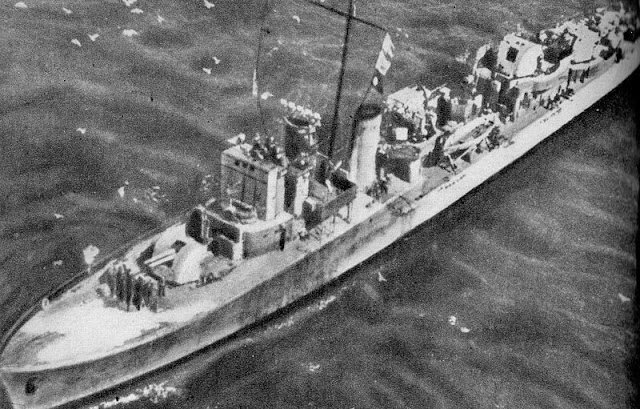 |
| ORP Kujawiak. Commissioned on 17 June 1941, lost to a mine on 16 June 1942 near Malta during Operation Harpoon. |
At 04:30, the 5th Light Brigade resumes its counterattack against the British 7th Armoured Brigade. By 06:00, the Germans grind into the British positions and start pushing them back again.
At Fort Capuzzo, the British have planned a resumption of their offensive, but the Germans have been very active. This activity spooks the British commander, General Frank Messervy, who cancels the attack. The confusion on the British side reaches a fever pitch, and Middle East Commander General Archibald Wavell hurriedly boards a plane to fly from Cairo to the command post of front commander General Noel Beresford-Peirse at Sidi Barrani.
Meanwhile, General Rommel is reading the British wireless messages in real-time and knows that Wavell himself now is involved. As he writes later:
It sounded suspiciously as though the British commander no longer felt himself capable of handling the situation. It being now obvious that in their present bewildered state the British would not start anything for the time being, I decided to pull the net tight by going on to Halfaya.Rommel repeatedly uses words like "bewildered" and "complained bitterly" to describe the tone of the British intercepts, which he obviously reads with great delight. One can almost hear him laughing at the image of Wavell rushing to the airport to fly to the scene of the end of his career.
This is one of Rommel's truly great operations, though little-remembered amongst his other successes. He demonstrates true talent as a counter-puncher, turning a well-played defensive battle into an opportunity to push the enemy back. Rommel reorients his counter-offensive on the fly to take account of the changed circumstances. He directs the 5th Light Division and 15th Panzer Division in a concentric attack, the former from the southwest and the latter from the northwest, on Halfaya, to destroy the fleeing British troops. The panzers reunite with their trapped comrades in Halfaya Pass without difficulty and only fail to encircle the main body of British tanks and infantry because they are headed east so fast.
At 10:00, the Germans brush aside the remaining tanks of the 4th Armoured Brigade, which was ruined by previous ill-fated attacks on German positions protected by hidden anti-tank guns. The local British commanders agree by 10:45 on a general retreat, and the British spend the rest of the day abandoning all of their remaining gains and retreating back into Egypt.
June 17, 1941, marks the last remnant of Operation Battleaxe, which has been a disaster for the British. The Allies have suffered 122 killed, 588 wounded and 259 missing men, while the Germans have 93 killed, 350 wounded and 235 missing. The British also lose 98 tanks (3 light, 30 cruisers, and 65 Matildas), while the Germans lose about 50 tanks total. The Germans recover the field of battle and thus get both their own wrecked tanks to salvage and also the British tanks for study and possible repair. The outcome in the air is similar, with the RAF losing 33 fighters and 3 bombers against total Luftwaffe losses of ten planes.
Luftwaffe ace Hans-Joachim Marseille shoots down two Hawker Hurricanes over Halfaya Pass while flying escort for Junkers Ju 87 Stuka dive-bombers. They are his victories 12 and 13.
Operation Battleaxe has been as futile as Operation Brevity in mid-May despite the concentration of massive British armored forces brought by the Tiger Convoy. The Germans advance to Sidi Suleiman and then pause. Not only have the British not gained any ground, in fact, but they also wind up 30 miles further east than they started.
I regret to report the failure of "Battleaxe."Winston Churchill did not have to read anything after that. He is furious with his generals in the Middle East, all of whom he quickly will replace. He was obsessed for the past month oversupplying the Middle East Command with tanks from England, and, instead of the great victory he desired and frankly expected, all that effort now is wasted. He blames the reversals on ineffective commanders and supposed slackers in the British army. The real reason for the British problems in North Africa, though, is simply that the German forces are too effective at this stage of the war.
Dutch submarine O-24 (P 24), commanded by Lt. Commander Otto de Booy, is operating off La Spezia, Italy when it attacks a target. However, the torpedoes miss.
The 173 Tunnelling Company, Royal Engineers is ordered to Malta to dig underground facilities. The government on the island has decided that the surface is becoming too hazardous and wants to build a headquarters, storage area and operating theater in the mountains. An air raid in the early morning hours damages Iz-Zebbieh, Hal Far, Luqa, Ta Qali, and Rabat.
 |
| "Bristol Blenheim Mark IVs taxying out for an air-test after assembly at Tengah, Singapore, following their urgent shipment to the theatre." June 1941 (© IWM (K 1175)). |
Spy Stuff: The Japanese begin assembling copies of secret charts for Panama from Italian officials. These charts show the location of guns, equipment, and buildings in the Canal Zone. The Japanese, however, are unsure how to get the charts from Panama to Tokyo without the Americans finding out because baggage in the area is being routinely opened and searched.
Pavel M. Fitin, chief of the NKVD Foreign Intelligence, sends Soviet Premier Joseph Stalin a report which asserts in part:
all preparations by Germany for an armed attack on the Soviet Union have been completed, and the blow can be expected at any time.NKVD man Fitin knows this report is valid: the source is within Reichsmarschal Hermann Goering's own air ministry. However, at this point, Stalin has a stack of warnings of an invasion in his filing cabinet. As with the others, Stalin files it.
US/Canadian Relations: The US and Canada set up a Joint Economic Committee. Its purpose is to:
study and to report to their respective governments on the possibilities of (1) effecting a more economic, more efficient, and more coordinated utilization of the combined resources of the two countries in the production of defence requirements (to the extent that this is not now being done) and (2) reducing the probable post-war economic dislocation consequent upon the changes which the economy in each country is presently undergoing.This is another step on a long journey by the United States in supporting the British without actually declaring war on the Axis.
 |
| The unsuccessful Brewster SB2A-4 Buccaneer. A total of 1052 are built, and many are never used but sent immediately to be scrapped. |
German Military: Adolf Hitler confirms 22 June 1941 as the date for Operation Barbarossa, the invasion of the Soviet Union. The invasion is to begin at 03:00 along three axes of advance: north, center, and south.
About 10,000 Wehrmacht troops assembled in Finland as co-belligerents (technically not allies) head north to take up positions near Petsamo in preparation for Barbarossa. Their aim is to secure vital nickel supplies and advance toward Murmansk.
The Luftwaffe engages in reconnaissance flights over the Soviet Union, largely without being spotted. The photos are of historical interest for showing undamaged locations that soon will become famous for being destroyed by combat. Yesterday the photographed Kharkiv, today Zapolyarny in the far north.
British Military: The British Army reestablishes the Guards Armoured Division. Its first commander is Major General Sir Oliver Leese.
 |
| The prototype Brewster Bermuda (the name given to the Brewster SB2A Buccaneer by the United Kingdom) on Long Island, summer of 1941. |
Finnish Military: General Heinrichs, the Finnish Chief of Staff, orders a general mobilization. All reservists up to the age of 44 are to report immediately for duty.
Finland announces that it is leaving the League of Nations, an organization that is moribund anyway.
Iceland: Sveinn Bjornsson is elected Regent of Iceland. While the Iceland military is occupied by the British (and soon the Americans), in other regards it continues to function independently.
 |
| David Lloyd George opens the new Welsh Services Club in London - 17-June-1941. |
Latvia: Soviet deportations of 7000 women, children, and elderly people conclude in Latvia. They are taken to Siberia on freight cars. Everybody is woken before or at dawn without warning, given an hour to pack, and everything that they leave behind is seized by the state.
Holocaust: Using the little-known back-door route to escape Europe, Jewish refugees aboard Japanese ship Hikawa Maru have arrived in Vancouver, Canada. The group includes many families with children.
SS-Obergruppenführer/General der Polizei Reinhard Heydrich conducts a briefing session in his Berlin office. Attending are the commanders of Einsatzgruppe, Einsatzkommando, and Sonderkommando units in preparation for Operation Barbarossa.
Having just returned from a three-day SS conclave held at Castle Wewelsburg, Heydrich sets out in detail the policies to be followed by the Einsatzgruppen ("Task Forces"). These policies will include following the advancing army troops and serving as mobile execution squads of Jews and other undesired locals such as communist functionaries.
There is to be no judicial proceeding, no discussion - the intended victims are to be taken to places outside of town and shot without ceremony. Einsatzgruppen are composed of members of the SS, Gestapo, Criminal Police, and State Security Service. The colloquial name for Einsatzgruppen is "death squads."
American Homefront: New York Yankee Joe DiMaggio gets a hit in his 30th straight game, this one against the Chicago White Sox. This breaks the team record set by Roger Peckinpaugh and Earl Coombs, both of whom are in attendance to see the record fall.
 |
| Graduating class of the Casey Jones School of Aeronautics in Newark, New Jersey, 17 June 1941. The US Army Air Corps becomes the US Army Air Force three days later, 20 June 1941. |
June 1, 1941: Farhud Pogrom
June 2, 1941: Massacres on Crete
June 3, 1941: Kandanos Massacre
June 4, 1941: Kaiser Wilhelm Passes Away
June 5, 1941: Death in Chungking
June 6, 1941: Hitler's Commissar Order
June 7, 1941: Commandos Strike at Pessac
June 8, 1941: British Invade Syria and Lebanon
June 9, 1941: Litani River Battle
June 10, 1941: British Take Assab
June 11, 1941: Hitler Thinking Beyond Russia
June 12, 1941: St. James Agreement
June 13, 1941: Lützow Damaged
June 14, 1941: Latvian June Deportations
June 15, 1941: Operation Battleaxe
June 16, 1941: The Old Lion
June 17, 1941: British Spanked in North Africa
June 18, 1941: Turkey Turns Its Back
June 19, 1941: Cheerios Introduced
June 20, 1941: Birth of US Army Air Force
June 21, 1941: Damascus Falls
June 22, 1941: Germany Invades Russia
June 23, 1941: A Soviet KV Tank Causes Havoc
June 24, 1941: Kaunas and Vilnius Fall
June 25, 1941: Finland Declares War
June 26, 1941: Bombing of Kassa
June 27, 1941: Encirclement At Minsk
June 28, 1941: Minsk Falls
June 29, 1941: Brest Fortress Falls
June 30, 1941: Mölders Becomes Top Ace
2020




